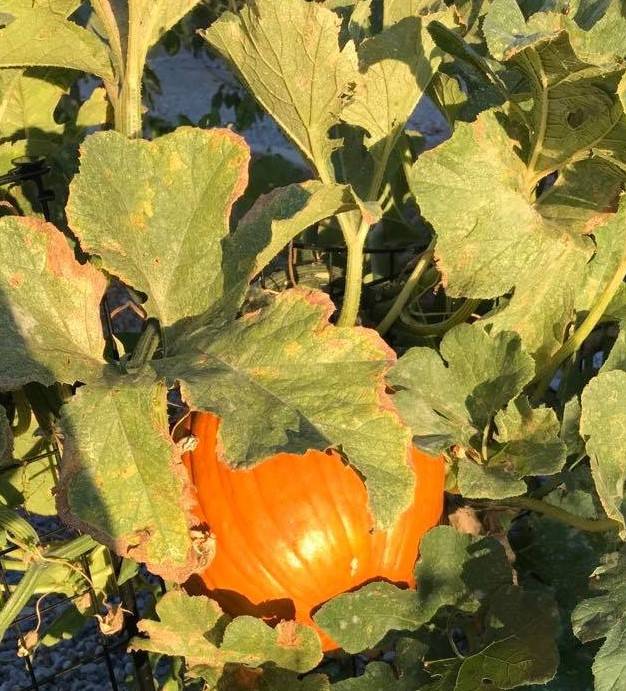
Fourth of July weekend may have you thinking of fireworks and barbecue, but there is another tradition you may want to add to your list: planting pumpkins.
Pumpkin has been a staple crop in the United States since long before our independence. In the early days of our country, pumpkin was consumed on a regular basis in a variety of dishes from stews to casseroles. Over time, carving designs into a freshly hollowed out pumpkin became a Halloween tradition and these days Americans rarely eat pumpkin other than the occasional pumpkin pie.
I have encountered many who are surprised that anything can be planted during our hottest days of the year, but this is the perfect time to plant pumpkin and other squash as well as melon and cucumber. By planting now, you can avoid a host of pest issues and diseases such as squash vine borer and powdery mildew.
A wide world of pumpkin varieties:
There is a dizzying array of pumpkin varieties that you can choose from. Most small-to mid-sized pumpkins are not only great for carving but will also give you the best flavor. My favorite pumpkin variety to grow is Jack-o-Lantern.
I first purchased a packet from a local farmer at the farmers market and I have saved my seed every year since.
Another variety that is fun and grows well in our region is Jarrahdale. It has a pale blue-green ribbed skin and deep orange flesh. It is sure to be a conversation piece at any fall dinner table. Seeds for Jarrahdale pumpkin can be purchased at many online retailers.
Growing and caring for pumpkin:
To plant pumpkin, choose a growing spot that receives at least 8 hours of sun per day, full sun is best. If you are growing the pumpkins as a project with your children, I suggest planting one plant per family member.
Prepare your planting site ahead of time by amending the soil with compost, manure, and other organic matter.
Pumpkins are a heavy feeder and will require a lot of nutrition as they grow. Make small hills of about 1-inch high and one foot in circumference. Space the hills at least three feet apart. Heavily mulch the area with straw, grass clippings, or wood chips to keep down weeds and conserve water.
Plant three to four seeds in the middle of each hill. The seeds should be planted at the depth of one inch. I poke the seed into the soil up to my first knuckle. Rake back the mulch from the center of the hill when planting and do not let the mulch touch the base of the stem as the plant grows. After planting, give the soil a good watering until it is damp.
Seedlings should emerge in seven to 10 days. When the plants reach a height of three to four inches, thin them to just two plants per hill. To thin the plants, cut the smallest, least healthy-looking plants at the base where the stem emerges from the ground. Do not pull them out as this will disturb the roots of the surrounding plants.
Water daily, keeping the soil moist. Avoid watering the foliage and water the soil instead to prevent powdery mildew. My squash is watered by my dripline, which runs for 10 minutes, three times a day during most of July and August.
Feed your pumpkins at least every other week. Just like the rest of my garden, I feed my pumpkin plants with compost tea. You can find my article, “Turning your pesky weed problem into garden gold,” for more information on this method on pvtimes.com
As the fruit forms and begins to grow, placing a wooden board under it will help to keep it from rotting and thwart pests.
Common problems when growing squash:
Check the vine daily for problems as it grows. Squash bugs lay their eggs in small clusters of brownish eggs on the underside of leaves. They can be removed easily by rubbing them off. Kill adult squash bugs as you see them. I take a bucket of soapy water with me to the garden and throw the squash bugs into the bucket as I find them.
If you find a plant that is overrun with squash bugs, act quickly to save the plant as squash bugs can kill it in a day or less. Flooding the area during the hottest part of the day will send the squash bugs crawling to the top of the plant where they will be easier to catch. I know of some master gardeners who vacuum them up with a small hand-held vacuum.
Another pest you may encounter is the squash vine borer. Check the stems of the plants for small brown oval eggs. The larvae bore into the stem and grow. If your plant suddenly wilts and dies, this is most likely the cause. Wrapping a thin layer of medical tape around the stem at the base can help thwart the problem.
How to harvest pumpkin:
Your pumpkin will be ready for harvest once its color has turned from green to orange. If you press your fingernail into the skin, it should resist puncture. Cut the pumpkin carefully from the vine with a sharp pair of shears. Leave at least 2 inches of stem attached to your pumpkin. This will help the pumpkin last in a cool dark storage area for several months.
Working in the garden when temps soar past 100 degrees may not be your idea of fun, but establishing a new holiday tradition with your children and experiencing the payoff in fall will make it all worth it.
Terri Meehan is the Founder of Southern Nevada Gardening Association a regional group. She is a garden mentor and local farmer in Pahrump. Send questions or comments to her at sonvgarden@gmail.com